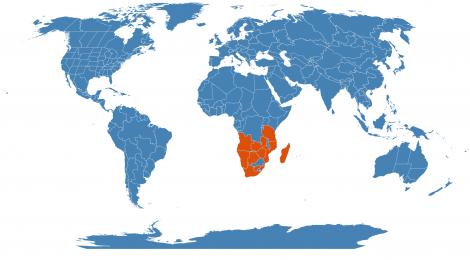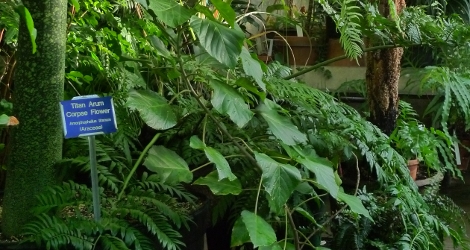Accession Data:
Ipomoea bolusiana Schinz
subg. Eriospermum sect. Erpipomoea
- Common Name:
- Family: Convolvulaceae Juss.
- Country of Origin: southern Africa, Madagascar

- Habitat: tuberous geophyte of open woodland or grassland, in sandy or rocky soil
- Description: Glabrous perennial geophyte. Rootstock tuberous, one to several light brown tubers per plant, mostly subglobose, also spindle-shaped to ovoid, up to 130 mm in diameter, frequently quite deep underground at the upper end of an up to 300 mm long taproot; ± milky inside. Stems annual, one or several, spreading, erect or prostrate, slender, woody at base, erect stems up to 300 mm high, prostrate ones up to 3 m or longer, pale green. Leaves either palmately 3–9-sect (mainly on prostrate stems) with segments 20–70 × 0.5–3.0 mm, or simple, linear to bilobed, 40–150 × 2–7 mm, sometimes petiole or axis; also applied to how the lateral veins are arranged in relation to the main vein.">pinnate, if 3 then terminal segments partly fused to form a common rhachis, keeled, dark green above, margins ± revolute, also serrated or undulate; petiole of dissected leaves up to ± 20 mm long, of simple leaves sometimes inconspicuous. Peduncles 1-flowered, usually very short; bracteoles often deciduous; pedicels short, thickened. Sepals lanceolate to elliptic or broadly ovate, acute or acuminate, equal or unequal, dark green with hyaline margins, persistent in fruit, 7–20 mm long. Corolla funnel-shaped, 40–70 × 40–60 mm, usually bright magenta-pink, lighter outside and darker in centre and on midpetaline areas, also lighter pink to reddish or purplish. Capsule subglobose-conical, red-brown, 10–12 mm long and in diameter, apex often depressed, apiculate by style base, splits into 4 sections. Seeds 4, 4.5–7.0 mm long, densely covered with 4–6 mm long, shiny, silky, fawn hairs. Chromosome number: unknown.
Accession Data:
- Accession # 201700092
- Source: Ken Mosher via M. Opel
- Accession Date: 12-13-2017
- Bench: 2208 - XER:Horn of Africa
- Currently: active - healthy
- Qty: 1 confirmed on 04-14-2025
Classification:
- Division: Magnoliophyta
- Class: Magnoliopsida
- SubClass: euasterid I
- Order: Solanales
- SubOrder:
- Family: Convolvulaceae
- SubFamily: Convolvuloideae
- Tribe: Ipomoeeae
- SubTribe:
Flowering Data:
This accession has been observed in bloom on:| Year | Jan | Feb | Mar | Apr | May | Jun | Jul | Aug | Sep | Oct | Nov | Dec | ||||||||||||||||||||||||||||||||||||||||
|---|---|---|---|---|---|---|---|---|---|---|---|---|---|---|---|---|---|---|---|---|---|---|---|---|---|---|---|---|---|---|---|---|---|---|---|---|---|---|---|---|---|---|---|---|---|---|---|---|---|---|---|---|
| 2025 | ||||||||||||||||||||||||||||||||||||||||||||||||||||
| 2024 | ||||||||||||||||||||||||||||||||||||||||||||||||||||
| 2023 | ||||||||||||||||||||||||||||||||||||||||||||||||||||
| 2022 | ||||||||||||||||||||||||||||||||||||||||||||||||||||
| 2021 | ||||||||||||||||||||||||||||||||||||||||||||||||||||
| 2020 | ||||||||||||||||||||||||||||||||||||||||||||||||||||
| 2019 | ||||||||||||||||||||||||||||||||||||||||||||||||||||
| 2018 | ||||||||||||||||||||||||||||||||||||||||||||||||||||
References (internal):
- EEB Greenhouse Holdings native to: Tanzania / Angola / Mozambique / Zambia / Zimbabwe / Botswana / Cape Provinces / Namibia / KwaZulu-Natal / Free State / Swaziland / Madagascar
References (external):
- Hyde, M.A., Wursten, B.T., Ballings, P. & Coates Palgrave, M. (2017). Flora of Zimbabwe: Species information: Ipomoea bolusiana. Last accessed on Wednesday, December 20, 2017.
- The Plant List (2013). Version 1.1. Last accessed on Wednesday, December 20, 2017.
- Flowering Plants of South Africa Biodiversity Advisor - SANBI, Volume 65, June 2017. Last accessed on Thursday, 04 April, 2019.
data regenerated on Wed, 02 Jul 2025 10:00:04 -0400 [bcm v4.0]
Images:

Additional images for this accession:
Click on thumbnails to enlargeCurrent Accessions in the Convolvulaceae
Subfamily Convolvuloideae
Tribe Convolvuleae
Subfamily Convolvuloideae
Tribe Cresseae
Subfamily Convolvuloideae
Tribe Cuscuteae
Subfamily Convolvuloideae
Tribe Ipomoeeae
W/C = Wild Collected
 = indicates flowering in past 14 days
= indicates flowering in past 14 days
 = images available for this accession
= images available for this accession
 = map available for this accession
= map available for this accession
 = accession added within past 90 days
= accession added within past 90 days
